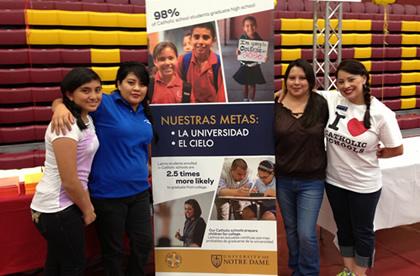A principal who's a proven recruiter of Latino students into Catholic schools sees four lessons to learn as the Alliance for Catholic Education's many-faceted campaign to serve more kids from all backgrounds continues to evolve.
Mary Flock, who leads St. Gertrude the Great School in Bell Gardens, CA, came to Notre Dame for the Latino Enrollment Institute (LEI) in 2011 to hear the first iteration of guidelines for more inclusive and accessible Catholic schools.
She put them into practice, and total enrollment jumped from a nadir of 42 to today's 175 students. Flock returned to campus recently and offered her to-do list for an evolving campaign: four takeaways to inform your school's efforts to welcome and recruit new families.

1. Fair models of tuition flexibility based on need are crucial to a school's mission and identity, but apply these models by combining sensitivity, full information, and mutual responsibility.
Sliding tuition scales, imperative if inner-city schools are to remain open, affordable, and mission-focused, can be scary, Flock said. In the past, school and parish leaders often feared that any "negotiation" of tuition levels would spark abuses and complaints. But flexibility works if the context combines responsiveness to needs, enduring relationships, and enforced responsibilities.
Many families in financial hardship who still want a quality education for their children approach Flock with requests for assistance, and she's ready to listen, but she requires a two-way understanding. "I interview all of my families." She can make arrangements that adjust to temporary crises, but she tells parents, "You've got to check in with me every month" so she's informed of changing conditions. If families don't communicate, she can withdraw special tuition breaks, and improprieties—which she has found are rare—can result in a student's expulsion.
The compassionate commitment to make a quality education available to kids from all backgrounds is inseparable from fairness and accountability, Flock said. "It all boils down to: Am I staying true to the mission?" She has seen very little manipulation, and parent complaints about cost are small compared to their appreciation for the school's values: "It's the integrity of the situation that I uphold, not the nitpicking of the details."
2. Expect every path to a more culturally responsive school to take its own turns over time, generating new ideas and opportunities to learn.
Outreach strategies that might have seemed like unilateral, one-size-fits-all approaches early in this decade gain new dimensions as principals from different communities report their unique experiences, Flock said. Novices still want basic insights—tips about multi-cultural openness, sliding tuition scales, etc.—as workable first steps. But those who have made strides now have follow-up questions and new ideas, like those voiced at the LEI every June.
For example, while many LEI schools had recruited madrinas—women highly respected in local Latino communities—to promote their schools, most volunteers who stepped forward to serve in Flock's Los Angeles-area community were men, or padrinos.
Flock suggests that recruiters routinely ask those principals enjoying enrollment turnarounds, "What are you doing, and how can we help you be a change-maker?"
3. Identify and reach out to benefactors who share a passion for Catholic schools of the future, but earn their support in real time, through authentic relationships, focusing on the students.
Growing awareness of Catholic schools' legacy as a lifeline for generations of immigrants has stirred support among benefactors and philanthropic organizations, Flock said. More principals and pastors now need to understand the dynamics of these valued partnerships.
Flock's experience reflects the need for personal trust, honest encounters, and proven leadership. Generous donors she has worked with want to see quality people comfortable in the school, with reasonable growth prospects already in the offing, not a setting of decline and desperation.
She said benefactors ask, "Does your school have the capacity to grow, and if so, what is your vision for growing it? What enrollment numbers are you looking for? A lot of the focus is capacity-building and leadership and transparency." Flock said supporters resonate with her intention: "I do it for the kids."
4. Expect to be surprised by the "side-effects" from a school's commitment to serve the disadvantaged, boost enrollment, and share its own Catholic character.
No one outline of Latino enrollment strategies can anticipate or encapsulate all the different impacts that arise in individual schools. Each principal will implement the strategies according to his or her personality, and it's important for principals to be themselves—"not trying to please everybody," Flock said. Indeed, schools have their own personalities, and it helps if a core charism adds consistency and joy to encounters with different cultures. Flock draws strength from her own school's Salesian values.
"Every one of my teachers knows every kid's name," and the students visit her with suggestions and dreams because they know "they're kids whom we love."
Commitments and initiatives like those shared by principals nationwide through ACE's annual Latino Enrollment Institute can have impacts far beyond a school's visual appeal or financial and strategic changes. Flock said she left her first Institute meeting with a new confidence that a turnaround was possible for St. Gertrude. "It was the idea of hope," and it proved contagious to staff members, parents, and students. ACE's work has indeed prompted personal transformations. When Flock arrived in 2011, "the kids felt squashed," she said. "It was a poor school with a poor man's mentality. Now, in the last two years, our students have blossomed."
 Alliance for Catholic Education
Alliance for Catholic Education
